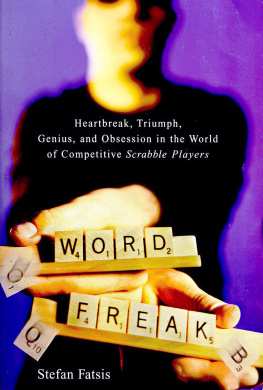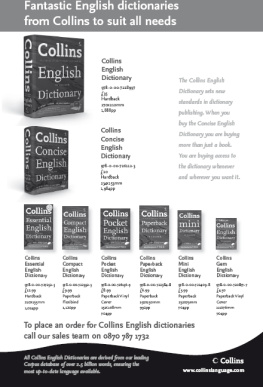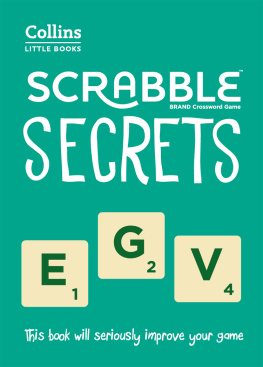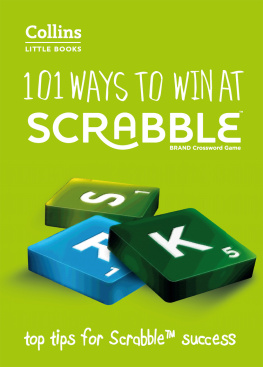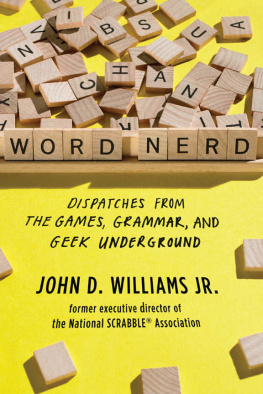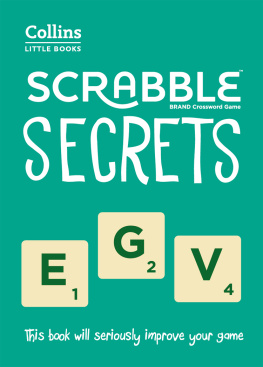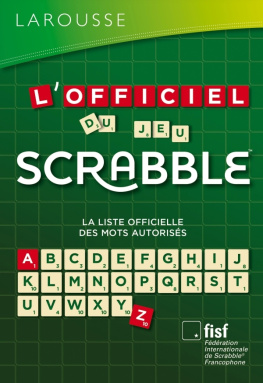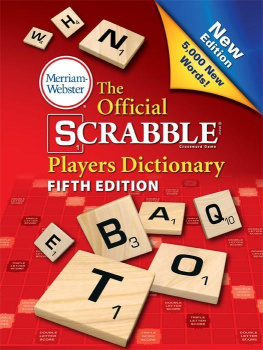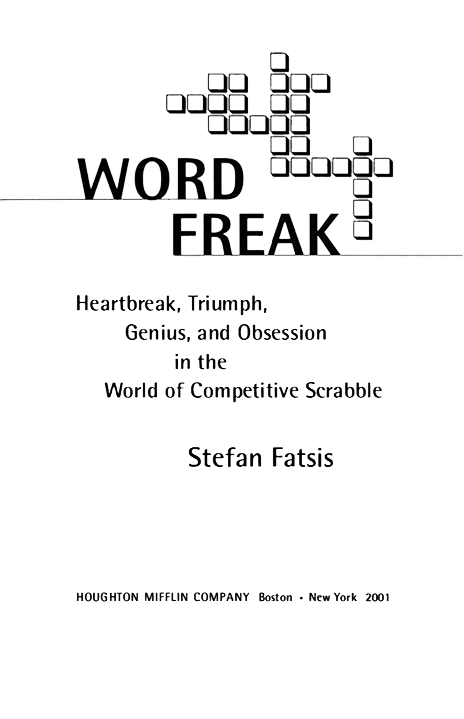
Table of Contents
For Lampros, Cindy, and Michael
Copyright 2001 by Stefan Fatsis
All rights reserved
For information about permission to reproduce selections from this book, write to Permissions, Houghton Mifflin Harcourt Publishing Company, 215 Park Avenue South, New York, New York 10003.
www.hmhbooks.com
The Library of Congress has cataloged the print edition as follows:
Fatsis, Stefan.
Word freak : heartbreak, triumph, genius, and obsession in the world of competitive Scrabble players / Stefan Fatsis.
p. cm.
ISBN 0-618-01584-1
1. Scrabble (Game)Tournaments. I. Title.
GV1507.S3 F38 2001
793.734dc21 2001016912
eISBN 978-0-547-52431-3
v2.0315
Excerpt from pulled down shade copyright 1992 by Charles Bukowski. Reprinted from The Last Night of the Earth Poems with the permission of Black Sparrow Press.
SCRABBLE & 2001 Hasbro, Inc., in the United States and Canada only.
For information on Scrabble clubs, tournaments, and other activities contact:
North American Scrabble Players Association, P.O. Box 12115, Dallas, Texas, 75225-0115, www.scrabbleplayers.org
Preface
W HEN W ORD F REAK WAS first published in 2001, Scrabble had been an American institution for decades. In the ensuing years, to my delight and amazement, the game has become even more popular. But time changes even classics.
Word Freak is about the intersection of a game, the culture, and the language. As youll discover in a new afterword, some fundamental aspects of those relationships have changed. The Internet has revolutionized how people play Scrabble. The daily evolution of the English language has altered the basic tools of the game, the words. Corporate exigencies have transformed the power structure that governs this little world. And the characters you are about to meetmyself includedhave taken new steps on their Scrabble journeys.
But the essence of the game invented by an unassuming New York City architect in the 1930s remains timeless, and the devotion of the people who fall under its spell remains the same as when I researched and wrote this book: all-consumingly, terrifyingly, mesmerizingly, happily complete.
Stefan Fatsis
February 2013
Authors Note
T HE WORLD OF GAMES and the world of words are governed by their own sets of elaborate rules. This book is about one game, Scrabble, and the words used in playing that game. So its only natural that it has a few rules of its own, too.
First, a little background: Organized, competitive, tournament Scrabble differs from the game played at home. A twenty-three-page rule book governs everything from how to select tiles properly (the bag containing them must be held at eye level or higher) to what to do when a player needs to go to the bathroom during a game (a situation that just happens to fall under Rule II P). Ive tried to make clear the rules and conventions of tournament play as they arise in the course of the narrative. One, however, bears mentioning up front: Competitive Scrabble is a one-on-one game. Casual games sometimes are played two-on-two or two-on-one, but there are never more than two sides.
The basic rules, however, are the same regardless of whether one is playing in a tournament or at the beach. The purpose is to make words. Players take turns making them. Points are totaled according to designations on the letters and on premium squares on the Scrabble board which double or triple the value of a letter or word. The back of the cover of the box from the first version manufactured in 1948 offers as good an explanation as any of the rules of the game. (If you already know how to play, feel free to skip ahead.)
- Each player draws seven tiles and places them on his rack.
- The first player combines two or more of his letters to form a word and places it on the board to read either across or down with one letter on the center square. Diagonal words are not permitted.
- A player completes a turn by counting and announcing the score for the turn. He then draws as many new letters as he has played, thus always keeping seven letters on his rack.
- The second player, and then each in turn, adds one or more letters to those already played so as to form new words. All letters played in any one turn must be placed in one row across or down the board. They must form one complete word and if, at the same time, they touch other letters in adjacent rows, they must form complete words, crossword fashion, with all such letters. The player gets credit for all words formed or modified by his play.
- New words may be formed by:
a. Adding one or more letters to a word or letters already on the board.
b. Placing a word at right angles to a word already on the board. The new word must use one of the letters already on the board or must add a letter to it.
c. Placing a complete word parallel to a word already played so that adjoining letters also form complete words.
- The score for each turn is the sum of the score values of all the letters in each word formed or modified in the play plus the premium values resulting from placing letters on premium squares.
- When two or more words are formed in the same play, each is scored. The common letter is counted (with full premium values, if any) in the score for each word.
- Any player who plays all seven of his tiles in a single turn scores a premium of 50 points in addition to his regular score for the play.
- Play continues until all tiles have been drawn and one of the players has used all of the letters in his rack or until all possible plays have been made.
The Scrabble board is a fifteen-by-fifteen grid. There are one hundred tiles in a set, ninety-eight letters and two blanks. For reference, the following tables denote the frequency of each tile in the set and their point values.
A-9
B-2
C-2
D-4
E-12
F-2
G-3
H-2
I-9
J-1
K-1
L-4
M-2
N-6
O-8
P-2
Q-1
R-6
S-4
T-6
U-4
V-2
W-2
X-1
Y-2
Z-1
Blanks-2
0 points: Blanks
1 point: A, E, I, L, N, O, R, S, T, U
2 points: D, G
3 points: B, C, M, P
4 points: F, H, V, W, Y
5 points: K
8 points: J, X
10 points: Q, Z
While it isnt necessary to memorize the tile frequencies and point values in order to read this bookor to know anything at all about Scrabble, for that matterthere are a few important notes about the text itself:
- Letters, groups of letters, and words referred to in the context of the game are written in capital letters.
- Blanks are denoted by a question mark.
- Groups of letters are listed in alphabetical order, and the blank or blanks always go last. For instance, a rack containing the letters E, A, M, O, N, D, and a blank would be written as ADEMNO?.
- When a word includes a blank, the letter represented by the blank is written in lowercase. The tiles in the above example can be used to form eight seven-letter words, which would be written as AbDOMEN, ADENOMa (or aDENOMA, depending on whether the blank is designated as the first or last letter), AMiDONE, DAEMONs, MADrONE, MAsONED, MONADEs, and wOMANED.
I occasionally use diagrams to illustrate board positions. The four abbreviations on a diagram represent the premium squares. The abbreviations are DLS (double-letter score), DWS (double-word score), TLS (triple-letter score), and TWS (triple-word score). The center square, a star on the board, is a DWS. Heres an example:
Next page
